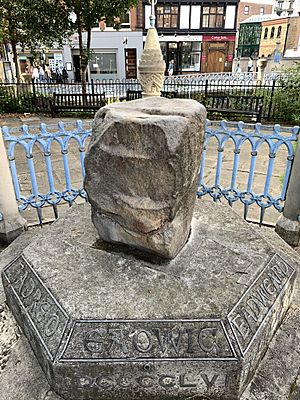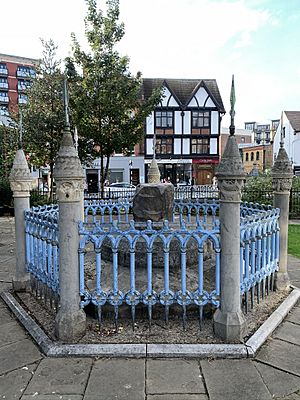Coronation Stone, Kingston upon Thames facts for kids
The Coronation Stone is a very old stone block. It is made of a type of rock called sarsen, which is a hard sandstone found in southern England. People believe this stone was used for the coronation (crowning ceremony) of seven Anglo-Saxon kings. These kings ruled England a long, long time ago.
Today, you can find the Coronation Stone in Kingston upon Thames, England. It sits right next to the Guildhall, which is a main public building. Kingston is now a town in Greater London, but it's still an important place for the county of Surrey.
What's in a Name?
The name "Kingston" has a special meaning. In Old English, which was spoken many centuries ago, words like tun, ton, or don meant a farmstead or a small settlement. So, "Kingston" likely means "the farmstead of the kings."
There's a local story that Kingston got its name because kings were crowned there. However, old records from a meeting in 838 show that the name "Kingston" was already in use before these coronations happened.
History of the Stone
Many important kings were crowned in Kingston. Here are some of them:
- Æthelstan became king in Kingston in 925.
- Eadred was crowned in 946.
- Æthelred the Unready became king in 979.
There is also some proof that other kings were crowned in the town. These include Edward the Elder, Edmund I, Eadwig, and Edward the Martyr.
A writer named John Stow wrote in the late 1500s that Æthelstan was crowned on a stage in the market square. Later, people thought the kings were crowned inside an old church called St Mary's. This church sadly fell down in 1730.
Soon after the church collapsed, a large stone block was found in its ruins. People then believed this was the actual "Coronation Stone" used by the kings of England. For a while in the late 1700s and early 1800s, it was even used as a mounting block (a step to help people get onto horses).
In 1850, the stone was moved to the market square. It was placed on a special base in front of the old Town Hall. This base had the names of the seven kings believed to have been crowned on the stone carved around its sides.
Future Plans for the Stone
In 2017, the Kingston Council (the local government) thought about moving the Coronation Stone again. They considered taking it from its spot in front of the Guildhall. The idea was to move it back to its original location. This would be inside the churchyard of Kingston's old parish church, All Saints Church.



